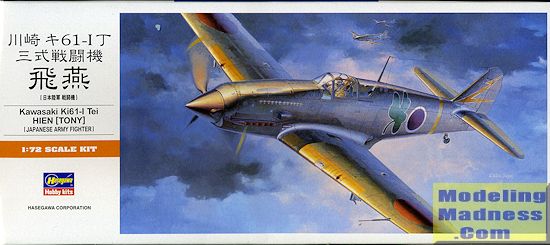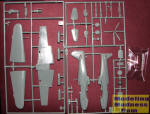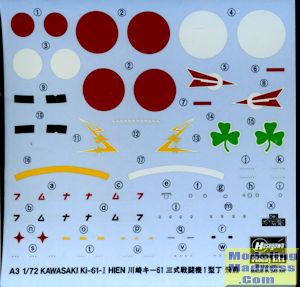
Hasegawa 1/72 Ki-61 'Tony'
| KIT #: | 00133 |
| PRICE: | 800 yen SRP |
| DECALS: | Two options |
| REVIEWER: | Scott Van Aken |
| NOTES: | 2009 boxing |

| HISTORY |
The Kawasaki Ki-61 Hien (飛燕, "flying swallow") is a Japanese World War II fighter aircraft used by the Imperial Japanese Army Air Force. The first encounter reports claimed Ki-61s were Messerschmitt Bf 109s: further reports claimed that the new aircraft was an Italian design, which led to the Allied reporting name of "Tony", assigned by the United States War Department. As an interesting aside, the officer in charge of providing names to Japanese planes generally chose 'hill-billy' names (Zeke, Alf, Nell) in an attempt to further denigrate the Japanese in the eyes of the American soldier and public in general. The Japanese Army designation was "Army Type 3 Fighter" (三式戦闘機). It was the only mass-produced Japanese fighter of the war to use a liquid-cooled inline V engine. Over 3,000 Ki-61s were produced. Initial prototypes saw action over Yokohama during the Halsey-Doolittle Raid on 18. April 1942, and continued to fly combat missions throughout the war. As usual, many planes were made unserviceable by a supply situation that bordered on non-existent.
| THE KIT |
 This
is one of Hasegawa's early engraved panel line kits. As such, it is somewhat
light on detail, especially in the cockpit. In fact, the cockpit consists of
three parts; a floor with molded in seat, a seat back and an instrument panel
(with decal). No rudder pedals, no control stick. A pilot figure is supplied for
the seat and one standing on the ground is also included.
This
is one of Hasegawa's early engraved panel line kits. As such, it is somewhat
light on detail, especially in the cockpit. In fact, the cockpit consists of
three parts; a floor with molded in seat, a seat back and an instrument panel
(with decal). No rudder pedals, no control stick. A pilot figure is supplied for
the seat and one standing on the ground is also included.
Before joining the fuselage halves, one installs a blanking plate above the ventral radiator section and attaches the prop onto the prop shaft. Once closed, a forward ventral radiator piece is installed. Wings consist of a complete lower section with the two upper pieces containing the control surfaces and the wing tips. Tail planes are one piece with the rudder molded onto one fuselage half. There is no wheel well detail. Gear is nicely done and the gear doors will need to be cut. The wheels are very plain, but then so were the real ones. Aftermarket are available (or have been in the past).
 For under
the wings are two fuel tanks. The small pylons are molded into the lower wing.
The spinner has no backing plate and attaches over the prop. Exhaust can be
installed after the model has been painted. The supercharger intake is also a
separate piece.
For under
the wings are two fuel tanks. The small pylons are molded into the lower wing.
The spinner has no backing plate and attaches over the prop. Exhaust can be
installed after the model has been painted. The supercharger intake is also a
separate piece.
Markings are for two planes. One is the box art plane with the 244 Sentai with a large green shamrock. Note that this plane had the nose gun openings covered over. The other is with the 17th Sentai in the Philippines and is in overall unpainted metal with green squiggles on the upper surface. The decal sheet is new to this boxing and is up to modern standards. Note that the yellow wing leading edge ID stripes are not included as decals so will need to be painted in place as will the nose anti-glare area on the second option.
| CONCLUSIONS |
The Ki-61 had not gotten all that much press in this scale. Revell did one back in the dark ages, Fine Molds does a rather expensive kit and I believe that Sword or RS have also released Tonys. This one is probably the easiest to build, the least expensive and looks very much like the standard -1 Hien. As many of you know, Hasegawa has a 'standard' boxing that is pretty much always available and produces limited editions with upgraded parts or decals. This kit is the new standard boxing, hence it is pretty inexpensive. I picked up this one as I noticed I did not have a Hien in my IJAAF 'Ki-' collection.
| REFERENCES |
http://en.wikipedia.org/wiki/Kawasaki_Ki-61
May 2015 Thanks to me for the preview kit. If you would like your product reviewed fairly and fairly quickly, please
contact
the editor or see other details in the
Note to
Contributors.